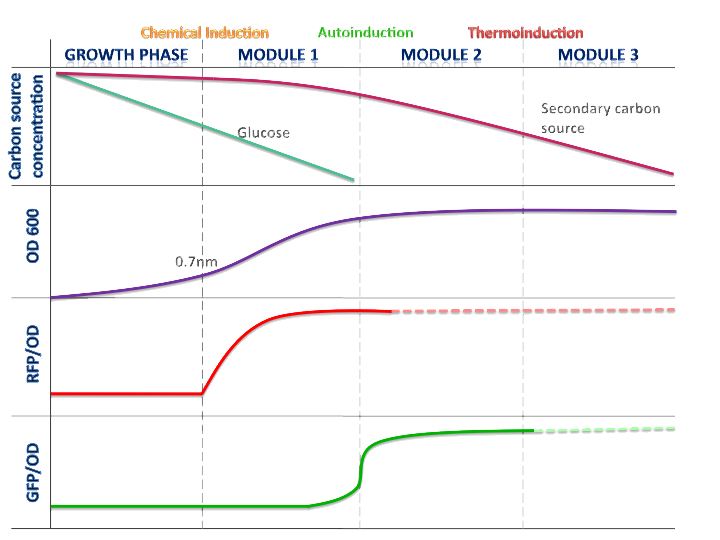Team:Imperial College London/Temporal Control
From 2009.igem.org
(Difference between revisions)
(→50pxTemporal Control) |
(→50pxTemporal Control) |
||
| Line 10: | Line 10: | ||
This timeline shows the sequence of events occuring within the system. <br> | This timeline shows the sequence of events occuring within the system. <br> | ||
*Starting from the top, we have the different carbon sources responsible for autoinduction of the system. The primary carbon source is glucose, as this is preferentially used by the cell. Also present in the media is a secondary carbon source, which is used by the cell after glucose in the media is depleted. By carefully balancing the initial concentrations of these carbon sources, 'The E.ncapsulator' will begin <b>Module 2</b> only once protein production is at sufficiently high levels. | *Starting from the top, we have the different carbon sources responsible for autoinduction of the system. The primary carbon source is glucose, as this is preferentially used by the cell. Also present in the media is a secondary carbon source, which is used by the cell after glucose in the media is depleted. By carefully balancing the initial concentrations of these carbon sources, 'The E.ncapsulator' will begin <b>Module 2</b> only once protein production is at sufficiently high levels. | ||
| - | + | *OD600 corresponds to the optical density of the cells. At sufficiently low levels of cell density, the absorbance of light at 600nm has a linear relationship with the cell density. This plot therefore models the growth of the cells throughout. | |
| + | *RFP is part of the same operon as the protein of interest. As the protein of interest is produced, RFP is coexpressed alongside. By monitoring the RFP levels within the system, we can monitor the levels of protein within the cell. The RFP must be normalised against optical density (shown above), as the cell density is increasing throughout. | ||
Revision as of 08:57, 12 October 2009

 Temporal Control
Temporal Control
In our project there are 3 forms of temporal control that have been implemented.
- Chemical induction: Triggers the production of drug of interest using IPTG.
- Autoinduction: Represses encapsulation when glucose levels are high, and kickstarts it once glucose is used up.
- Thermoinduction: Triggers genome deletion when the temperature is increased.
The timeline shows the sequence of occurrence of these events:
This timeline shows the sequence of events occuring within the system.
- Starting from the top, we have the different carbon sources responsible for autoinduction of the system. The primary carbon source is glucose, as this is preferentially used by the cell. Also present in the media is a secondary carbon source, which is used by the cell after glucose in the media is depleted. By carefully balancing the initial concentrations of these carbon sources, 'The E.ncapsulator' will begin Module 2 only once protein production is at sufficiently high levels.
- OD600 corresponds to the optical density of the cells. At sufficiently low levels of cell density, the absorbance of light at 600nm has a linear relationship with the cell density. This plot therefore models the growth of the cells throughout.
- RFP is part of the same operon as the protein of interest. As the protein of interest is produced, RFP is coexpressed alongside. By monitoring the RFP levels within the system, we can monitor the levels of protein within the cell. The RFP must be normalised against optical density (shown above), as the cell density is increasing throughout.


 "
"








